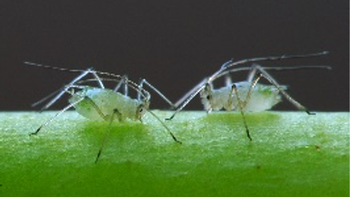Aphids
-
AboutSmall insects that suck fluids out of stems, leaves, and other tender plant parts. Soft pear-shaped bodies with long legs and antennae and may be green, yellow, brown, red, or black. A few species appear waxy or woolly due to the secretion of a waxy white or gray substance over their body surface. Generally, adult aphids are wingless, but most species also occur in winged forms. Ants protect aphids from their natural enemies.
 Photo: Wikimedia Commons
Photo: Wikimedia Commons -
CategoryInsect
-
Signs/Symptoms
May be found singly, aphids often feed in dense groups on leaves or stems. Large populations can turn leaves yellow and stunt shoots. Can produce large quantities of a sticky exudate known as honeydew. Appearance of black on foliage with the growth of a sooty mold fungus.
-
Where
Almost every plant has one or more aphid species that occasionally feed on it. Expect aphids when you grow flowering plums, roses, tulip trees, crape myrtles, apples, and many vegetables. Aphids like lush, new growth.
-
When
Most often in spring. When the weather is warm, many species of aphids can develop from newborn nymph to reproducing adult in seven to eight days.
-
Prevent
High levels of nitrogen fertilizer favor aphid reproduction; use organic or slow-release products. Before planting vegetables, check surrounding areas for sources of aphids and remove these sources. Reduce losses by growing seedlings under protective covers in the garden. Keep ants off plants to help natural enemies of aphids do their job.
-
Manage
Prune infested leaves and stems. Knock aphid populations off plants by shaking the plant or spraying it with a strong stream of water. Wait for hot weather; some aphids are heat-intolerant and will be gone by mid-summer. If insecticides are needed, insecticidal soaps and oils are the best choices for most situations.
Beneficial insects will visit plants naturally when aphids are abundant. Common natural enemies of aphids include:
Lady beetles (ladybugs), both adults and larvae
Tiny parasitic wasps that turn aphids into crusty “mummies”
-
More Information

